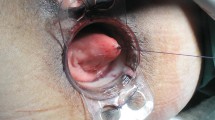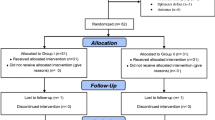Abstract
Background: This study aimed to evaluate clinically and manometrically the anorectal function of patients with imperforate anus after repair with laparoscopically assisted anorectoplasty (LAR), as compared with the function of patients after undergoing the conventional method, posterior sagittal anorectoplasty (PSARP). Methods: The defecation status and anorectal manometry of patients with high or intermediate type imperforate anus repaired with LAR (n = 9) and age-matched patients repaired with PSARP (n = 13) were assessed and compared during the first year of postoperative follow-up evaluation. The defecation status was classified by the frequency of bowel openings (<1, 1–4, and >5 times per day). Manometric assessment was performed by an open-tip hydraulic capillary infusion system. The presence of the rectoanal relaxation reflex was determined, and the resting sphincteric pressure and resting rectal pressure were measured. Results: Seven of nine LAR patients had an “acceptable” frequency of one to four bowel openings per day, in contrast to 7 of 13 PSARP patients. The difference in the presentation of daily stooling is not significant (p > 0.05). A positive RAR was detected in 88.9% (8/9) of the LAR patients, and in only 30.8% (4/13) of the PSARP patients (p < 0.01). The presence of a rectoanal relaxation reflex also significantly correlated with an acceptable frequency of bowel opening (1–4 times per day) in both LAR and PSARP patients (p < 0.05). Moreover, a rectoanal relaxation reflex was detected significantly earlier in LAR than in PSARP patients (4.9 ± 1.2 vs 10.1 ± 2.5 months; postoperatively p < 0.0001). Both the LAR and PSARP patients had a similar resting sphincteric pressure (21.5 ± 4.7 vs 25.4 ± 6.2 cm H2O; p > 0.05). By contrast, the resting rectal pressure was significantly lower in LAR than in PSARP patients (7.7 ± 1.5 vs 11.5 ± 1.3 cmH2O; p < 0.05). Conclusions: In the early postoperative stage, patients repaired with LAR had more favorable findings in anorectal manometry than patients repaired with PSARP. Long-term follow-up studies to confirm a superior defecation continence achieved with LAR are warranted.


Similar content being viewed by others
References
C-C Chen C-L Lin W-T Lu W-M Hsu JC Chen (1998) ArticleTitleAnorectal function and endopelvic dissection in patients with repaired imperforate anus. Pediatr Surg Int 13 133–137 Occurrence Handle1:STN:280:DyaK1c3isVWhsQ%3D%3D
P deVries A Peña (1982) ArticleTitlePosterior sagittal anorectoplasty. J Pediatr Surg 17 638–643 Occurrence Handle1:STN:280:BiyD1critlw%3D Occurrence Handle7175658
B Frenchkner C van Euler (1975) ArticleTitleInfluence of pudendal block on the function of the anal sphincters. Gut 16 482–489 Occurrence Handle1150119
KE Georgeson TH Inge CT Albanese (2000) ArticleTitleLaparoscopically assisted anorectal pull-through for high imperforate anus: a new technique. J Pediatr Surg 35 927–931 Occurrence Handle1:STN:280:DC%2BD3cvps1KhtQ%3D%3D
B Husberg H Lindahl R Rintala B Frenckner (1992) ArticleTitleHigh and intermediate imperforate anus: results after surgical correction with special respect to internal sphincter function. J Pediatr Surg 27 185–189 Occurrence Handle1:STN:280:By2B38npt1c%3D
EM Keily A Peña (1998) Anorectal malformations. JA O’Neill MI Rowe JL Grosfeld (Eds) Pediatric surgery. Mosby St. Louis, MO 1445–1448
WB Kiesewetter (1967) ArticleTitleImperforate anus II: the rationale and technique of sacroabdominoperineal operation. J Pediatr Surg 2 106–117
RATM Langemeijer JC Molennar (1991) ArticleTitleContinence after posterior sagittal anorectoplasty. J Pediatr Surg 26 587–590 Occurrence Handle1:STN:280:By6B1cnpsVE%3D Occurrence Handle2061815
C-L Lin C-C Chen (1996) ArticleTitleThe rectoanal relaxation reflex and continence in repaired anorectal malformations with and without an internal sphincter-saving procedure. J Pediatr Surg 31 630–633 Occurrence Handle1:STN:280:ByiD3MvmtlI%3D Occurrence Handle8861469
A Peña D Amroch C Baeza L Csury G Rodriguez (1993) ArticleTitleThe effects of the posterior sagittal approach on rectal function (experimental study). J Pediatr Surg 28 773–778 Occurrence Handle8331501
F Rebein (1967) ArticleTitleImperforate anus: experiences with abdominoperineal and abdominosacroperineal pull-through procedures. J Pediatr Surg 2 99–105
AF Scharli WB Kiesewetter (1969) ArticleTitleImperforate anus: anorectosigmoid pressure studies as a quantitative evaluation of postoperative continence. J Pediatr Surg 4 694–704 Occurrence Handle1:STN:280:CS%2BC3MzptVw%3D Occurrence Handle5371098
FB Stephens (1953) ArticleTitleImperforate anus: a new surgical technique. Med J Aust 2 202
I Taylor HL Duthie RB Nachary (1973) ArticleTitleAnal continence following surgery for imperforate anus. J Pediatr Surg 8 497–503 Occurrence Handle1:STN:280:CSuD2c7mslI%3D
JS Verma AN Smith (1985) ArticleTitleAbnormality of colorectal function in intractable constipation following hysterectomy. Gut 26 581–582
Author information
Authors and Affiliations
Corresponding author
Rights and permissions
About this article
Cite this article
Lin, C., Wong, K., Lan, L. et al. Earlier appearance and higher incidence of the rectoanal relaxation reflex in patients with imperforate anus repaired with laparoscopically assisted anorectoplasty . Surg Endosc 17, 1646–1649 (2003). https://doi.org/10.1007/s00464-002-9246-3
Received:
Accepted:
Published:
Issue Date:
DOI: https://doi.org/10.1007/s00464-002-9246-3




